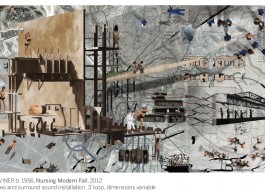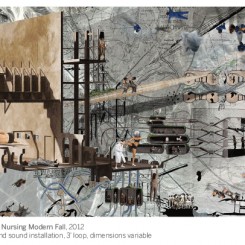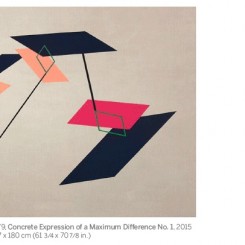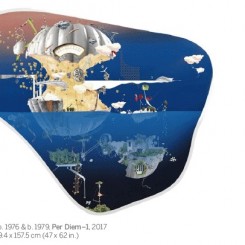Pearl Lam Galleries, Singapore
Dharma Bum, Weixin Chong, Inci Eviner, Gao Weigang, Gonkar Gyatso, Hew Locke, Ben Loong, Francis Ng, Ged Quinn, Anne Samat, Melati Suryodarmo, Sinta Tantra, Thukral & Tagra, Zen Teh, and Yang Yongliang
Singapore—Pearl Lam Galleries is pleased to present Empirical Atlas, a group show featuring works by Dharma Bum, Weixin Chong (b. 1988), Inci Eviner (b. 1956), Gao Weigang (b. 1976), Gonkar Gyatso (b. 1961), Hew Locke (b. 1970), Ben Loong (b. 1988), Francis Ng (b. 1975), Ged Quinn (b. 1963), Anne Samat (b. 1973), Melati Suryodarmo (b. 1969), Sinta Tantra (b. 1979), Thukral & Tagra (b. 1976 and b. 1979), Zen Teh (b. 1988), and Yang Yongliang (b. 1980). The exhibition focuses on the relationship between identity and politics, as well as globalization, material production, and consumer culture. As new cartographies and systems of knowledge are created, the meaning of empire and its geopolitical structures become increasingly complex.
Empirical Atlas circumvents a Eurocentric worldview to scrutinize pretenses, imposed identities, and personas. The artists chosen for this show assume known identities in relation to civilization and society, while maintaining unique personalities. They each examine a facet of the world that has been imposed on them as a given in their lives, deconstructing and taking it to various extremes. National identities and power structures of foreign trade are explored, as are the body politics relating to gender and spirituality. Through role-playing, code-switching, and self-fashioning, they each respond to the aftermath of the empire by creating new means to frame the world.
Landscapes and architecture simultaneously draw new connections and reveal the inherent contradictions within our collapsed notions of time, space, and place. Reaching outward to society, these works blend modern spectacles of urban development with old-world references to comment on the intersections of power and collective history. True to the post-post-colonial experience, Empirical Atlas samples a range of politics, economies, and cultures. As it becomes near impossible to locate the local and native, the exhibition presents itself as a constant renegotiation between natural evolution and diasporic influences.
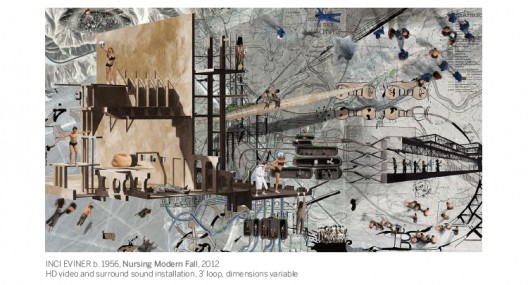
Melati Suryodarmo is concerned with the cultural, social, and political, articulating these concerns through her psychological and physical body. Through performance, she attempts to push through everyday encounters to engender new experiences.
Likewise, in Inci Eviner’s multi-layered works, the artist explores politics of desire, space, subjectivity and its potentiality. She follows the current practices of power on the female body and researches outside of the given identity that is in a continuous state of enactment.
Adopting many forms and materials, Gao Weigang presents great aesthetic variation within his work, with each piece challenging our preconceived visual vocabulary with humour and scepticism. His language makes each piece both the apparatus and product of transformation, breaking through our natural and ideological perceptions of our society.
Ben Loong’s Terra Blanca series examines geographical and geological phenomena, and considers it in the context of contemporary society. Working primarily with drywall plaster, these works engage with the material and personal realms, inviting the viewer to question the structure of our physical surroundings.
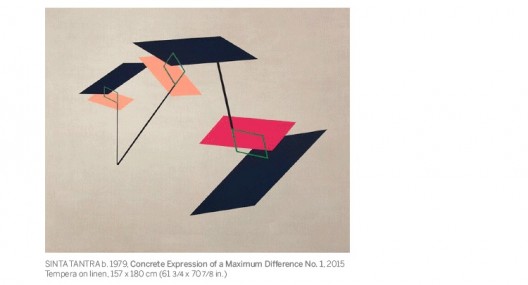
Francis Ng looks to articulate the history of “presence” in space through the effects of architectonic changes on people, often researching industrial materials and surveying the evolution of urban landscapes.
Despite the familiar aspects in Ged Quinn’s use of Western painting techniques, his introduction of incongruent imagery and cultural iconography creates a sense of haunting and dislocation. There is a constant sense of play between the references, which gives space for readings and narratives to develop and disappear.
Dharma Bum’s depiction of mysterious veiled figures against Western landscapes salvaged from thrift stores are also complicit in breaking down our assumptions, collapsing historicity and the boundaries between the internal and external. The works critique our sensibilities of civilization and otherness, generating political and cultural dialogue.
Working collaboratively to produce exuberant and darkly humorous works in a dizzying range of media, Jiten Thukral and Sumir Tagra, known as Thukral & Tagra, simultaneously serve up and participate in the globalized rampant consumer culture in India. The artists blur the line between high and low art, as well as commercial and artistic tastes.
Weixin Chong’s images play with themes of export and self-presentation. Hints of cross-cultural exchange can be inferred in the private, personal screen where multiple references both globalize and localize the scene. Exported and local flora are drizzled with makeup, suggesting the self- consciousness and self-awareness of a formerly colonized tropical body.
Gonkar Gyatso’s work is born out of a fascination with material and pop culture, along with a desire to bring equal attention to the mundane as well as the extraordinary. A Tibetan-born British artist, Gyatso’s personal experiences reflect a kind of hybridity and transformation, which can also be seen in his work.
Hew Locke explores the subject of power, particularly through the representation of royal portraiture, coats-of-arms, public statuary, trophies, company share certificates, weaponry, and costume. Successfully merging influences from both Guyanese and British cultures, he creates pieces that stand at a crossroads of cultures, mediums, and historic references.
Sinta Tantra’s bold interventions use bright abstractions that explore identity and aesthetics through a bricolage of colour and rhythm. Well regarded for her site-specific works in the public realm, Tantra splices together the interior and exterior world, questioning the relationship between painting and architecture. Influenced by her Balinese heritage, Tantra draws upon a bold and vibrant palette, creating works that celebrate spectacle and question the decorative, functional, and social role of the arts.
The installation pieces by Anne Samat are a metaphor for tradition and modernization, pairing the old with the new. In addition to practicing traditional weaving techniques, she is pioneering contemporary aesthetics within the craft. The works feature unique Malaysian songket and weave motifs, yet they are assembled with mass-produced, everyday objects to create a unique and dynamic style.
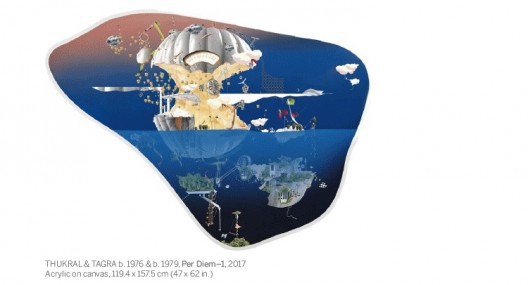
Zen Teh photographs landscapes and explores environmental issues across the globe, addressing the implications of global development on the natural environment. Teh produces photographs through a painterly perspective; she is constantly investigating alternative imaging processes. Her nuanced works often target the underlying issue caused by the rapidly changing landscape: the interrelation between human behaviour and nature.
Yang Yongliang is best known for the intricate landscapes he creates by integrating layers upon layers of urban and natural images together. Drawing from his formal education in the art of traditional Chinese shan shui (山水) painting, Yang’s work exudes a strong sense of traditional aesthetics, although he continually engages with the modern through his choice of media and content.

